Impacts of Recreational SCUBA Diving on a Natural Area in Puerto Vallarta, Mexico
Abstract
1. Introduction
Study Area
2. Materials and Methods
2.1. Divers Profile
2.2. Number and Type of Impacts
3. Results
3.1. Divers Profile
3.2. Quantity and Type of Contacts Exerted by SCUBA Divers on Seabed
4. Discussion
5. Conclusions
Author Contributions
Funding
Institutional Review Board Statement
Informed Consent Statement
Data Availability Statement
Acknowledgments
Conflicts of Interest
References
- PADI. 2019 Worldwide Corporate Statistics Data for 2013–2018; PADI: Rancho Santa Margarita, CA, USA, 2019. [Google Scholar]
- Worachananant, S.; Carter, R.W.; Hockings, M.; Reopanichkul, P. Managing the Impacts of SCUBA Divers on Thailand’s Coral Reefs. J. Sustain. Tour. 2008, 16, 645–663. [Google Scholar] [CrossRef]
- Bravo, G.; Márquez, F.; Marzinelli, E.M.; Mendez, M.M.; Bigatti, G. Effect of Recreational Diving on Patagonian Rocky Reefs. Mar. Environ. Res. 2015, 104, 31–36. [Google Scholar] [CrossRef]
- Hammerton, Z. SCUBA-Diver Impacts and Management Strategies for Subtropical Marine Protected Areas; Southern Cross University: East Lismore, Austrilia, 2014. [Google Scholar]
- Kenchington, R.A.; Hudson, B.E.T. Man’s threat to coral reefs. In Coral Reef Management Handbook; Kenchington, R.A., Hudson, B.E.T., Eds.; UNESCO: Jakarta, Indonesia, 1988; pp. 171–178. ISBN 92-3-102485-X. [Google Scholar]
- Lucrezi, S.; Saayman, M. Sustainable scuba diving tourism and resource use: Perspectives and experiences of operators in Mozambique and Italy. J. Clean. Prod. 2017, 168, 632–644. [Google Scholar] [CrossRef]
- Harriott, V.J.; Davis, D.; Banks, S.A. Recreational Diving and its impact in Marine protected areas in eastern Australia. Ambio 1997, 26, 173–179. [Google Scholar]
- Titus, B.M.; Daly, M.; Exton, D.A. Do Reef Fish Habituate to Diver Presence? Evidence from Two Reef Sites with Contrasting Historical Levels of SCUBA Intensity in the Bay Islands, Honduras. PLoS ONE 2015, 10, e0119645. [Google Scholar] [CrossRef]
- Bender, E.A.; Case, T.J.; Gilpin, M.E. Perturbation Experiments in Community Ecology: Theory and Practice. Ecology 1984, 65, 1–13. [Google Scholar] [CrossRef]
- Priskin, J. Tourist perceptions of degradation caused by coastal nature-based recreation. Environ. Manag. 2003, 32, 189–204. [Google Scholar] [CrossRef] [PubMed]
- Rátz, T.; Puczko, L. The Impacts of Tourism: An Introduction; Häme Polytechnic: Hämeenlinna, Finland, 2002; ISBN 9517840594. [Google Scholar]
- Gilpin, A. Environmental Impact Assessment (EIA): Cutting Edge for the Twenty-First Century; Cambridge University Press: Cambridge, UK, 1995; ISBN 0521429676. [Google Scholar]
- DOF—Diario Oficial de la Federación. Ley General del Equilibrio Ecológico y la Protección al Ambiente; Congreso de los Estados Unidos Mexicanos: Ciudad de México, Mexico, 2018; p. 135.
- Krieger, J.R.; Chadwick, N.E. Recreational diving impacts and the use of pre-dive briefings as a management strategy on Florida coral reefs. J. Coast. Conserv. 2013, 17, 179–189. [Google Scholar] [CrossRef]
- Pendleton, L.H. Environmental quality and recreation demand in a caribbean coral reef. Coast. Manag. 1994, 22, 399–404. [Google Scholar] [CrossRef]
- Dimmock, K.; Musa, G. Scuba Diving Tourism System: A framework for collaborative management and sustainability. Mar. Policy 2015, 54, 52–58. [Google Scholar] [CrossRef]
- Hasler, H.; Ott, J.A. Diving down the reefs? Intensive diving tourism threatens the reefs of the northern Red Sea. Mar. Pollut. Bull. 2008, 56, 1788–1794. [Google Scholar] [CrossRef] [PubMed]
- Zakai, D.; Chadwick-Furman, N.E. Impacts of intensive recreational diving on reef corals at Eilat, northern Red Sea. Biol. Conserv. 2002, 105, 179–187. [Google Scholar] [CrossRef]
- Álvarez del Castillo Cárdenas, P.A. Capacidad de Carga Turística por Buceo en el Parque Nacional Cabo Pulmo; Instituto Politécnico Nacional, Centro Interdisciplinario de Ciencias Marinas: La Paz, Mexico, 2012. [Google Scholar]
- Giglio, V.J.; Luiz, O.J.; Schiavetti, A. Marine life preferences and perceptions among recreational divers in Brazilian coral reefs. Tour. Manag. 2015, 51, 49–57. [Google Scholar] [CrossRef]
- Hammerton, Z. Determining the variables that influence SCUBA diving impacts in eastern Australian marine parks. Ocean Coast. Manag. 2017, 142, 209–217. [Google Scholar] [CrossRef]
- Wong, K.M.; Thirumoorthy, T.; Musa, G. SCUBA Diving Motivation. In Scuba Diving Tourism; Musa, G., Dimmock, K., Eds.; Routledge: New York, NY, USA, 2013; pp. 107–116. ISBN 9780128007228. [Google Scholar]
- Kler, B.K.; Moskwa, E. Experience, interpretation and meanings. In Scuba Diving Tourism; Musa, G., Dimmock, K., Eds.; 2013; pp. 134–151. ISBN 9781136324949. [Google Scholar]
- Thirumoorthy, T.; Wong, K.M.; Musa, G. SCUBA Diving Satisfaction. In Scuba Diving Tourism; Musa, G., Dimmock, K., Eds.; Routledge: New York, NY, USA, 2013; ISBN 9781136324949. [Google Scholar]
- Ong, T.F.; Musa, G. SCUBA divers’ underwater responsible behaviour: Can environmental concern and divers’ attitude make a difference? Curr. Issues Tour. 2012, 15, 329–351. [Google Scholar] [CrossRef]
- Toyoshima, J.; Nadaoka, K. Importance of environmental briefing and buoyancy control on reducing negative impacts of SCUBA diving on coral reefs. Ocean Coast. Manag. 2015, 116, 20–26. [Google Scholar] [CrossRef]
- Ballantyne, R.; Packer, J.; Hughes, K. Tourists’ support for conservation messages and sustainable management practices in wildlife tourism experiences. Tour. Manag. 2009, 30, 658–664. [Google Scholar] [CrossRef]
- Giglio, V.J.; Luiz, O.J.; Chadwick, N.E.; Ferreira, C.E.L. Using an educational video-briefing to mitigate the ecological impacts of scuba diving. J. Sustain. Tour. 2018, 26, 782–797. [Google Scholar] [CrossRef]
- Hammerton, Z.; Bucher, D. Levels of intervention—Reducing SCUBA-diver impact within subtropical marine protected areas. J. Ecotourism 2015, 14, 3–20. [Google Scholar] [CrossRef]
- Rangel, M.O.; Pita, C.B.; Gonçalves, J.M.S.; Oliveira, F.; Costa, C.; Erzini, K. Developing self-guided scuba dive routes in the Algarve (Portugal) and analysing visitors’ perceptions. Mar. Policy 2014, 45, 194–203. [Google Scholar] [CrossRef]
- Hammerton, Z. Low-impact diver training in management of SCUBA diver impacts. J. Ecotourism 2016, 16, 69–94. [Google Scholar] [CrossRef]
- Hein, M.Y.; Lamb, J.B.; Scott, C.; Willis, B.L. Assessing baseline levels of coral health in a newly established marine protected area in a global scuba diving hotspot. Mar. Environ. Res. 2015, 103, 56–65. [Google Scholar] [CrossRef] [PubMed]
- Lamb, J.B.; True, J.D.; Piromvaragorn, S.; Willis, B.L. Scuba diving damage and intensity of tourist activities increases coral disease prevalence. Biol. Conserv. 2014, 178, 88–96. [Google Scholar] [CrossRef]
- Andy, L.; Lee, R.-Y.; Tzeng, G.-H. Characteristics of Professional Scuba Dive Guides. Tour. Mar. Environ. 2014, 10, 85–100. [Google Scholar] [CrossRef]
- Di Franco, A.; Milazzo, M.; Baiata, P.; Tomasello, A.; Chemello, R. Scuba diver behaviour and its effects on the biota of a Mediterranean marine protected area. Environ. Conserv. 2009, 36, 32–40. [Google Scholar] [CrossRef]
- Delgado, J.P. The Impact on and Opportunities Arising from Tourism to Submerged Sites. In UNESCO Scientific Colloquium on Factors Impacting the Underwater Cultural Heritage; UNESCO, Ed.; Royal Library of Belgium: Brussels, Belgium, 2011; pp. 54–57. [Google Scholar]
- Chung, S.; Au, A.; Qiu, J.-W. Understanding the Underwater Behaviour of Scuba Divers in Hong Kong. Environ. Manage. 2013, 51, 824–837. [Google Scholar] [CrossRef]
- Di Franco, A.; Baiata, P.; Milazzo, M. Effects of recreational scuba diving on Mediterranean fishes: Evidence of involuntary feeding? Mediterr. Mar. Sci. 2013, 14, 15–18. [Google Scholar] [CrossRef]
- Santander Botello, L.C.; Propin Frejomil, E. Impacto ambiental del turismo de buceo en arrecifes de coral. Cuad. Tur. 2009, 24, 207–227. [Google Scholar]
- Giglio, V.J.; Luiz, O.J.; Schiavetti, A. Recreational Diver Behavior and Contacts with Benthic Organisms in the Abrolhos National Marine Park, Brazil. Environ. Manag. 2016, 57, 637–648. [Google Scholar] [CrossRef]
- Anderson, L.E.; Loomis, D.K. SCUBA Diver Specialization and Behavior Norms at Coral Reefs. Coast. Manag. 2011, 39, 478–491. [Google Scholar] [CrossRef]
- Lucrezi, S.; Ferretti, E.; Milanese, M.; Sarà, A.; Palma, M. Securing sustainable tourism in marine protected areas: Lessons from an assessment of scuba divers’ underwater behaviour in non-tropical environments. J. Ecotourism 2020. [Google Scholar] [CrossRef]
- Roche, R.C.; Harvey, C.V.; Harvey, J.J.; Kavanagh, A.P.; McDonald, M.; Stein-Rostaing, V.R.; Turner, J.R. Recreational Diving Impacts on Coral Reefs and the Adoption of Environmentally Responsible Practices within the SCUBA Diving Industry. Environ. Manag. 2016, 58, 107–116. [Google Scholar] [CrossRef] [PubMed]
- Uyarra, M.C.; Côté, I.M. The quest for cryptic creatures: Impacts of species-focused recreational diving on corals. Biol. Conserv. 2007, 136, 77–84. [Google Scholar] [CrossRef]
- Giglio, V.J.; Luiz, O.J.; Ferreira, C.E.L. Ecological impacts and management strategies for recreational diving: A review. J. Environ. Manag. 2020, 256, 109949. [Google Scholar] [CrossRef] [PubMed]
- DOF—Diario Oficial de la Federación. ACUERDO que Establece Como Zona de Refugio para la Protección de la Flora y Fauna Marinas, las Aguas Comprendidas en Los Arcos, Jalisco; SEMARNAT: Mexico City, Mexico, 1975; p. 1.
- Aranda Mena, O.S. Lista Sistemática de los Peces de Arrecife de Bahía de Banderas; Universidad de Guadalajara: Jalisco-Nayarit, Mexico, 2000. [Google Scholar]
- Medina-Rosa, P.; Cupul-Magaña, A. Los corales del área protegida Los Arcos: Sobrevivir a impactos humanos y naturales. Mexicoa 2001, 3, 86–91. [Google Scholar]
- Medina-Rosas, P. El Efecto de las Actividades Turísticas Sobre los Corales Pétreos (Cnidaria, Anthozoa, Scleractinia) de los Arcos; Universidad de Guadalajara: Jalisco, Mexico, 1997. [Google Scholar]
- Ramírez Cordero, C.A. Uso Ecoturístico y Capacidad de Carga de Buceo del Parque Nacional Islas Marietas y los Arcos de la Bahía de Banderas; Universidad de Guadalajara: Jalisco-Nayarit, Mexico, 2008. [Google Scholar]
- SEMAR/DIGAOHM; Secretaria de Marina/Dirección General Adjunta de Oceanografía. Agenda Turística del Golfo y Pacífico Mexicano—Jalisco; Secretaría de Marina: Ciudad de México, Mexico, 2018.
- Stokes, K.; Scammon, K.; Double, D.; Toon, K.; Hendricks, S.; Alfonso, A.; Jimenez, Z.; De La Pena, K.; Santos, K.C. Management of a Marine Park: Analysis of recreational and illegal fishing pressures on the reef fish assemblage at Los Arcos Reserve in Jalisco, Mexico. J. Fish. Life Sci. 2019, 4, 24–28. [Google Scholar]
- Cochran, W.G. Sampling Techniques, 3rd ed.; John Wiley & Sons: New York, NY, USA, 1977; ISBN 9781855736702. [Google Scholar]
- Casal, J.; Mateu, E. Tipos De Muestreo. Rev. Epidem. Med. Prev 2003, 1, 3–7. [Google Scholar] [CrossRef]
- Camp, E.; Fraser, D. Influence of conservation education dive briefings as a management tool on the timing and nature of recreational SCUBA diving impacts on coral reefs. Ocean Coast. Manag. 2012, 61, 30–37. [Google Scholar] [CrossRef]
- Edney, J.L. Lust for Rust: Wreck Divers and the Management of Underwater Cultural Heritage; Southern Cross University: East Lismore, Australia, 2018. [Google Scholar]
- Wiener, C.S. Understanding Spinner Dolphin Marine Tourism in Hawai’i: A Social Approach to Assessing Underwater Interactions; York University: Toronto, ON, Canada, 2016. [Google Scholar]
- PADI. 2020 Instructor Manual; PADI, Ed.; Professional Association of Diving Instructors: Rancho Santa Margarita, CA, USA, 2020. [Google Scholar]
- Jadot, C.; Bertuol, P.R.K.; Oliveira, G.; Krumholz, J.; de Leon, R. Intentional and accidental diver’s contact to reefs at popular locations in the Dutch Caribbean. In Proceedings of the American Academy of Underwater Sciences 35th Symposium, Dauphin Island, AL, USA, 20–24 September 2016; Lobel, L., Lombardi, M., Eds.; American Academy of Underwater Sciences: Narragansett, PI, USA, 2016; pp. 74–85. [Google Scholar]
- Rouphael, A.B.; Inglis, G.J. “Take only photographs and leave only footprints”?: An experimental study of the impacts of underwater photographers on coral reef dive sites. Biol. Conserv. 2001, 100, 281–287. [Google Scholar] [CrossRef]
- Zar, J.H. Biostatistical Analysis, 4th ed.; Pearson Education India: Upper Saddle River, NJ, USA, 1999; ISBN 9788177585827. [Google Scholar]
- Ong, T.F.; Musa, G. Examining the influences of experience, personality and attitude on SCUBA divers’ underwater behaviour: A structural equation model. Tour. Manag. 2012, 33, 1521–1534. [Google Scholar] [CrossRef]
- Luna, B.; Perez, C.V.; Sanchez-Lizaso, J.L. Benthic impacts of recreational divers in a Mediterranean Marine Protected Area. ICES J. Mar. Sci. 2009, 66, 517–523. [Google Scholar] [CrossRef]
- Þorbjörnsson, J.G.; Ólafsdóttir, J.H.; Kristjánsson, B.K.; Chambers, C.; Burns, G.L. Recreational scuba diving in a groundwater ecosystem: Disturbance mechanisms, ecological impacts and stakeholder perceptions. Aquat. Conserv. Mar. Freshw. Ecosyst. 2020, 30, 1012–1022. [Google Scholar] [CrossRef]
- PADI. PADI Course Catalog. Available online: https://www.padi.com/courses?discipline=826&experience-level=All&type=All&page=3 (accessed on 13 August 2020).
- Lucrezi Id, S.; Milanese, M.; Cerrano, C.; Palma, M. The influence of scuba diving experience on divers’ perceptions, and its implications for managing diving destinations. PLoS ONE 2019, 14, e0219306. [Google Scholar] [CrossRef] [PubMed]
- Richards, G.; Lénia, M.; Mein, K.; Marques, L.; Mein, K. Summary for Policymakers. In Climate Change 2013: The Physical Science Basis. Contribution of Working Group I to the Fifth Assessment Report of the Intergovernmental Panel on Climate Change; Stocker, T.F., Qin, D., Plattner, G.-K., Tignor, M., Allen, S.K., Boschung, J., Nauels, A., Xia, Y., Bex, V., Midgley, P.M., Eds.; Cambridge University Press: Cambridge, UK, 2013; pp. 3–29. ISBN 978-92-9169-138-8. [Google Scholar]
- Barraza, E. Buceo responsable en El Salvador. Real. Reflex. 2018, 18, 13–20. [Google Scholar] [CrossRef]
- Hawkins, J.P.; Roberts, C.M.; Van’T Hof, T.; De Meyer, K.; Tratalos, J.; Aldam, C. Effects of Recreational Scuba Diving on Caribbean Coral and Fish Communities. Conserv. Biol. 1999, 13, 888–897. [Google Scholar] [CrossRef]
- Anthony, K.R.N.; Marshall, P.A.; Abdulla, A.; Beeden, R.; Bergh, C.; Black, R.; Eakin, C.M.; Game, E.T.; Gooch, M.; Graham, N.A.J.; et al. Operationalizing resilience for adaptive coral reef management under global environmental change. Glob. Chang. Biol. 2015, 21, 48–61. [Google Scholar] [CrossRef]
- Barker, N.H.L.; Roberts, C.M. Scuba diver behaviour and the management of diving impacts on coral reefs. Biol. Conserv. 2004, 120, 481–489. [Google Scholar] [CrossRef]
- Ward, C.; Stringer, L.C.; Holmes, G. Protected area co-management and perceived livelihood impacts. J. Environ. Manag. 2018, 228, 1–12. [Google Scholar] [CrossRef]
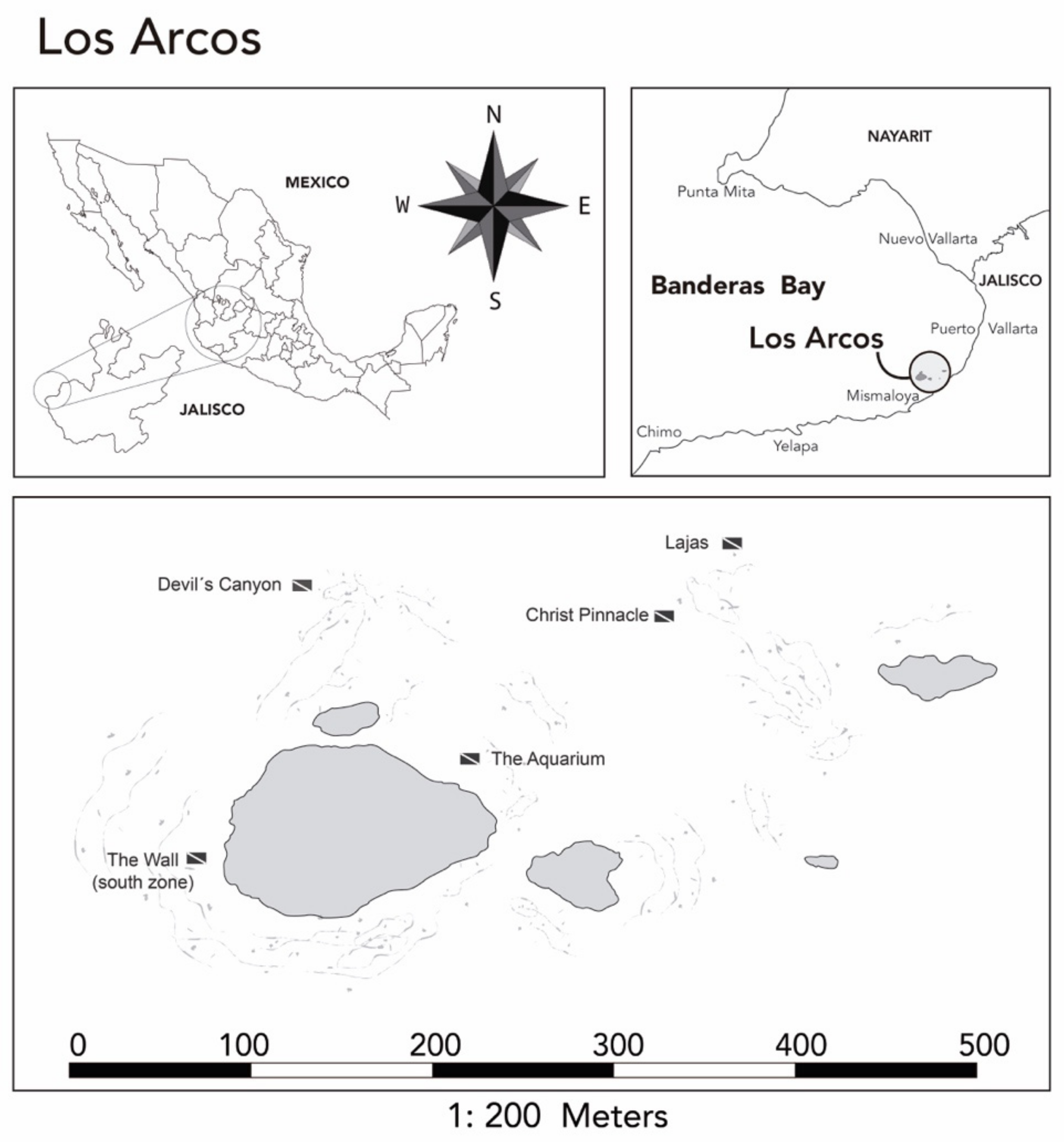
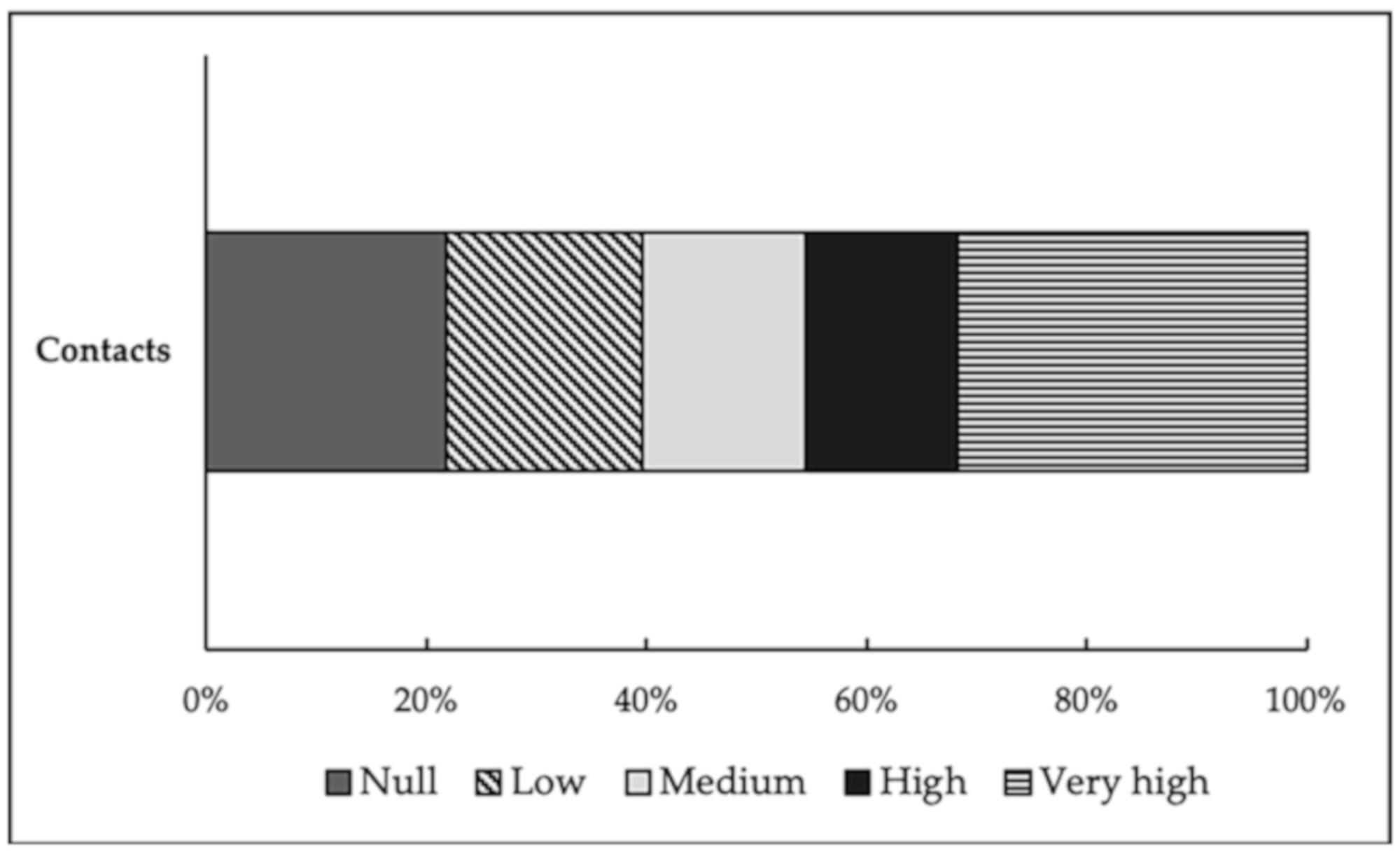
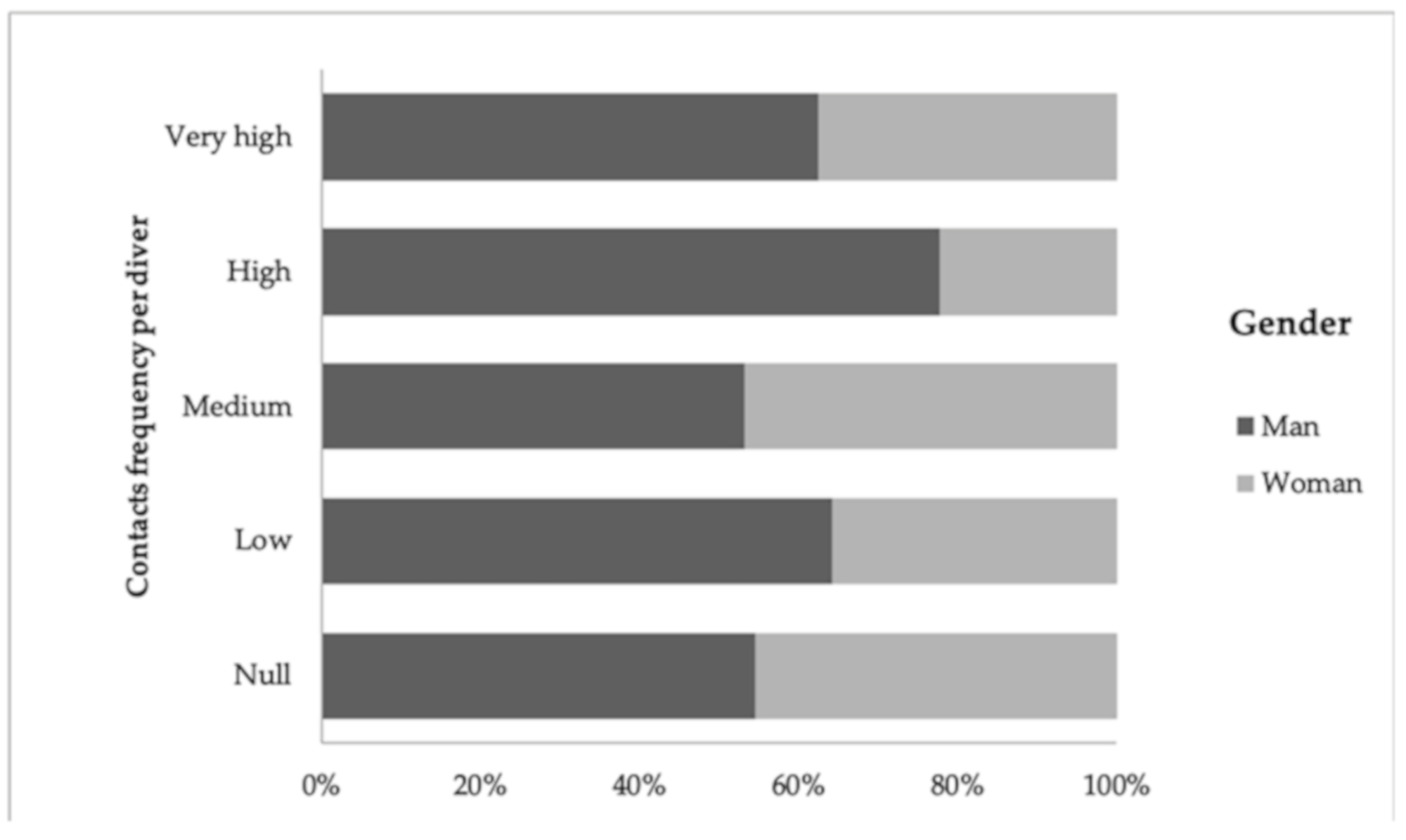
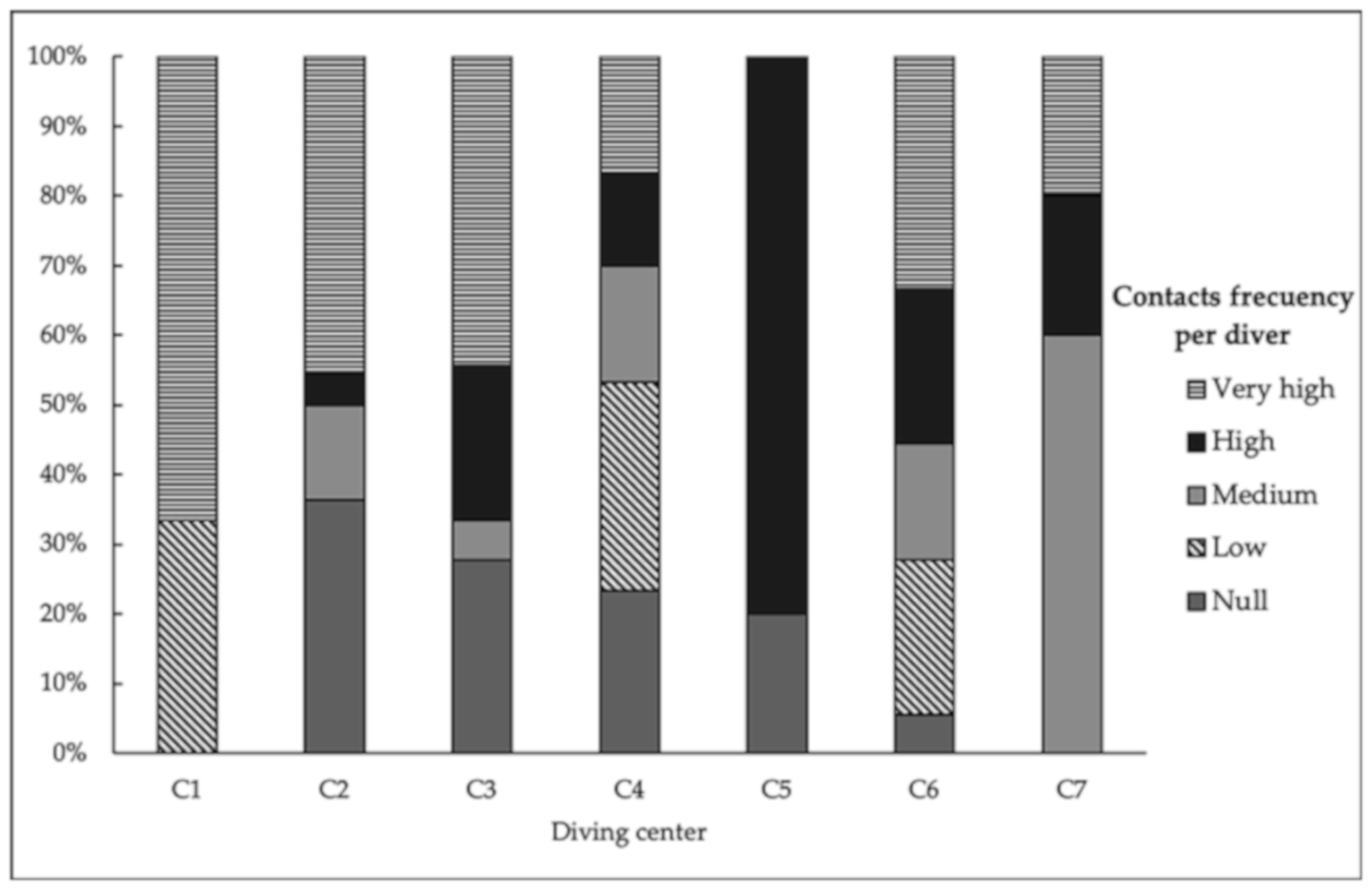
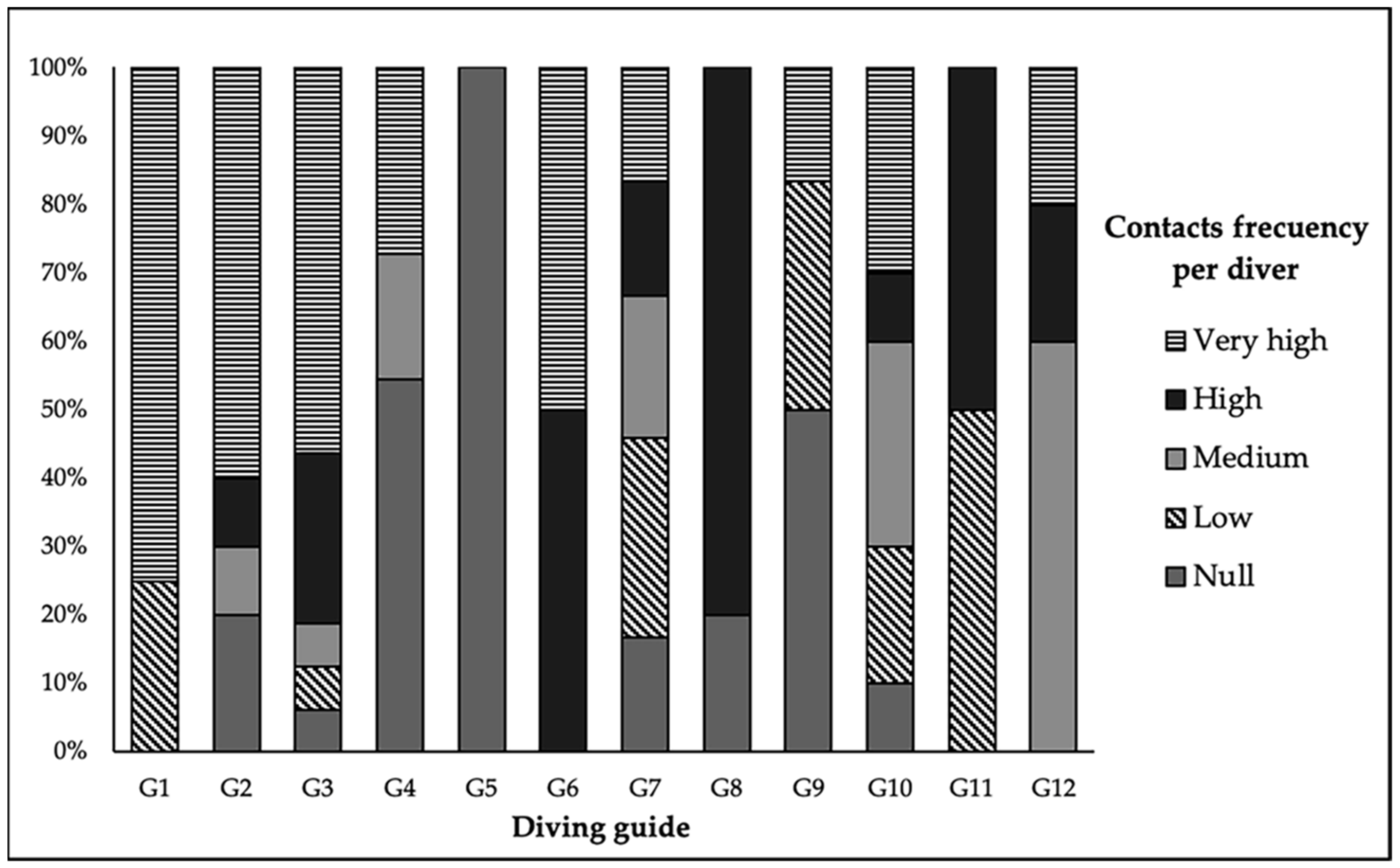
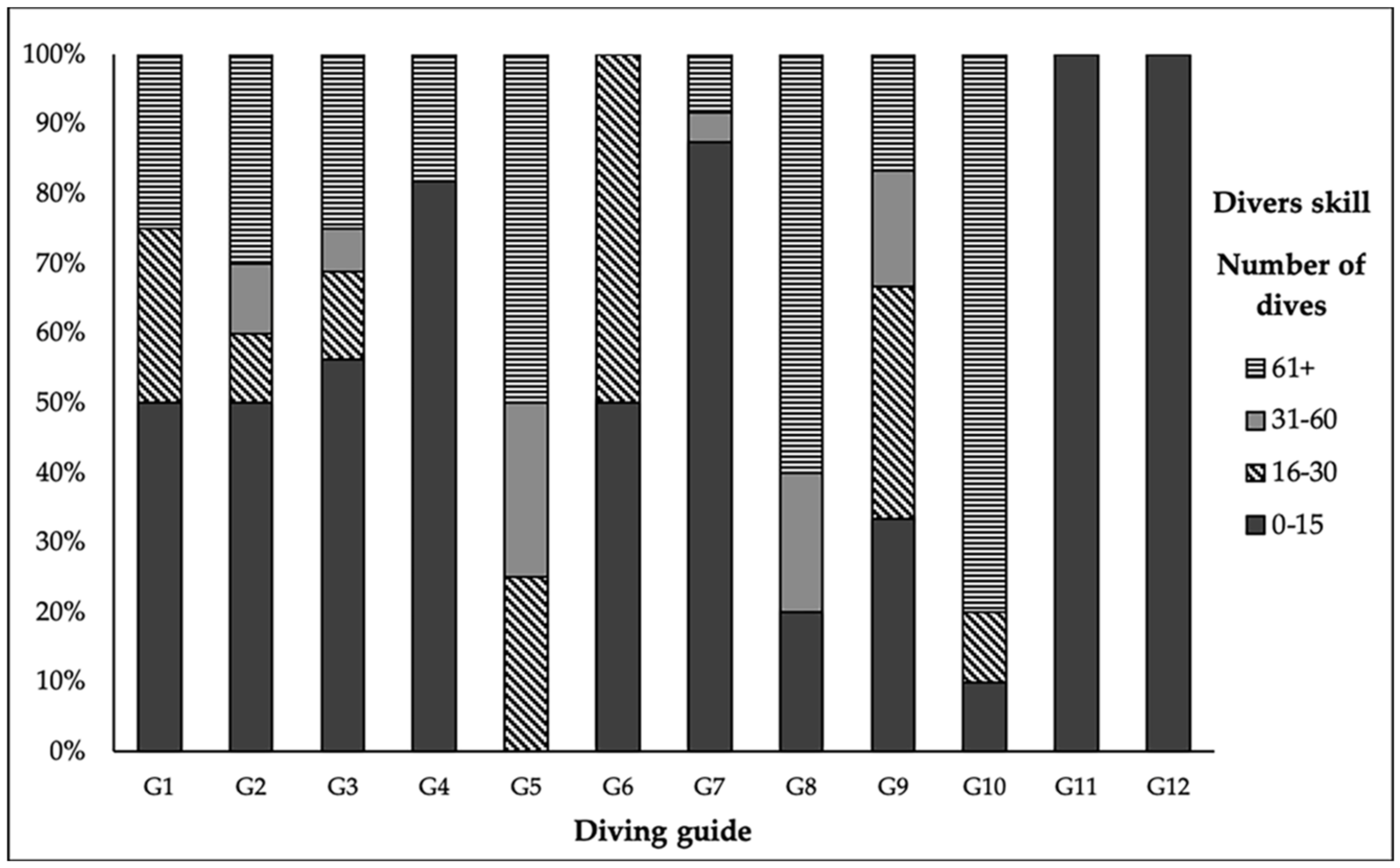
| Contact Frequency | 0–20 | 21–40 | 41–60 | 61–100 | ≥101 |
|---|---|---|---|---|---|
| Value assigned | “Null” | “Low” | “Medium” | “High” | “Very High” 1 |
| Contacts by Object | |||
|---|---|---|---|
| Intentional | Non-Intentional | ||
| Body Part or Equipment on Contact | Frequency | Body Part or Equipment on Contact | Frequency |
| Fin | 79 | Fin | 2357 |
| Tank | 0 | Tank | 18 |
| Pressure gauge | 5 | Pressure gauge | 160 |
| Camera | 14 | Camera | 3 |
| Hand | 159 | Hand | 100 |
| Knee | 44 | Knee | 279 |
| Lifting sediment | 0 | Lifting sediment | 6559 |
| SCUBA Center | Leader | Divers’ Number | Total–Contacts per Diver | Average Contacts per Diver in the Group | Average Total Contacts Leader |
|---|---|---|---|---|---|
| C1 | G1 | 3 | 302 | 101 | 10 |
| C2 | G2 | 13 | 1623 | 125 | 95 |
| C3 | G3 | 18 | 2134 | 117 | 38 |
| C2 | G4 | 9 | 259 | 27 | 0 |
| C3 | G5 | 4 | 32 | 8 | 5 |
| C3 | G6 | 4 | 1008 | 252 | 30 |
| C4 | G7 | 24 | 1599 | 67 | 0.5 |
| C5 | G8 | 5 | 337 | 67 | 11 |
| C4 | G9 | 6 | 201 | 34 | 0 |
| C6 | G10 | 10 | 547 | 55 | 1 |
| C6 | G11 | 2 | 106 | 53 | 0 |
| C7 | G12 | 5 | 462 | 92 | 20 |
| Certification Level | Average Contacts for SCUBA Diver | Contact Frequency Value |
|---|---|---|
| DSD 1 | 149.2 | Very High 101+ |
| OW | 104.6 | Very High 101+ |
| ADV | 36.38 | Low 21–40 |
| RESC | 53.33 | Medium 41–60 |
| DM | 5 | Null 0–20 |
| INST | 468 | Very High 101+ |
| Source | Observation Time | Average Contacts per Minute |
|---|---|---|
| Hammerton [21] * | 8 min | 1 times/min |
| Toyoshima & Nadaoka [26] | 30 min | 0.53 times/min |
| Worachananant et al. [2] * | 10 min | 1.6 times/min |
| Chung et al. [37] * | 25.8 average dive | 0.56 times/min |
| Giglio et al. [40] * | 30 min | 0.26 times/min |
| Jadot et al. [59] | 10 min | 0.54 times/min |
| Harriot et al. [7] | 10 min | Between 1.16 and 4.03 times/min |
| Luna et al. [63] * | 10 min | 4.12 times/min |
| Present study * | 35 min | 2.77 times/min |
Publisher’s Note: MDPI stays neutral with regard to jurisdictional claims in published maps and institutional affiliations. |
© 2021 by the authors. Licensee MDPI, Basel, Switzerland. This article is an open access article distributed under the terms and conditions of the Creative Commons Attribution (CC BY) license (https://creativecommons.org/licenses/by/4.0/).
Share and Cite
Balzaretti Merino, N.; Bravo-Olivas, M.L.; Chávez-Dagostino, R.M.; Medina-Rosas, P. Impacts of Recreational SCUBA Diving on a Natural Area in Puerto Vallarta, Mexico. Sustainability 2021, 13, 6249. https://doi.org/10.3390/su13116249
Balzaretti Merino N, Bravo-Olivas ML, Chávez-Dagostino RM, Medina-Rosas P. Impacts of Recreational SCUBA Diving on a Natural Area in Puerto Vallarta, Mexico. Sustainability. 2021; 13(11):6249. https://doi.org/10.3390/su13116249
Chicago/Turabian StyleBalzaretti Merino, Natalia, Myrna Leticia Bravo-Olivas, Rosa María Chávez-Dagostino, and Pedro Medina-Rosas. 2021. "Impacts of Recreational SCUBA Diving on a Natural Area in Puerto Vallarta, Mexico" Sustainability 13, no. 11: 6249. https://doi.org/10.3390/su13116249
APA StyleBalzaretti Merino, N., Bravo-Olivas, M. L., Chávez-Dagostino, R. M., & Medina-Rosas, P. (2021). Impacts of Recreational SCUBA Diving on a Natural Area in Puerto Vallarta, Mexico. Sustainability, 13(11), 6249. https://doi.org/10.3390/su13116249






